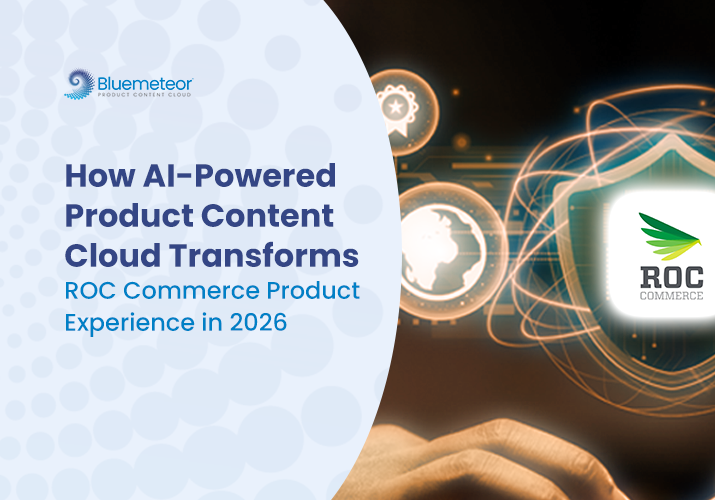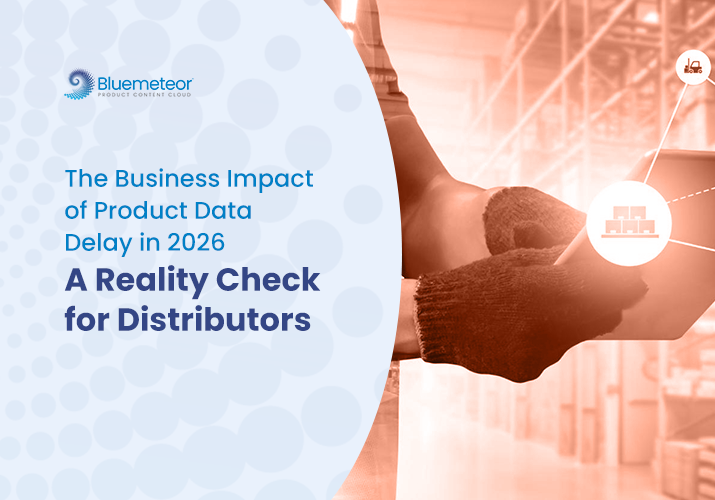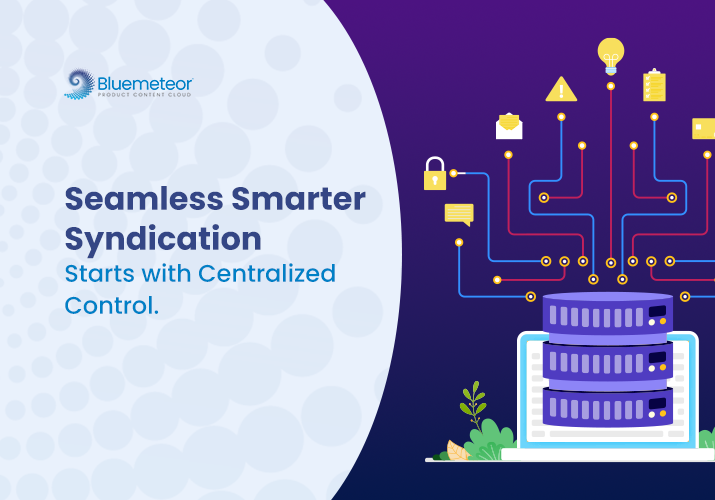Cracking the ERP Code: Solving Eclipse Integration Headaches for Electrical Distributors
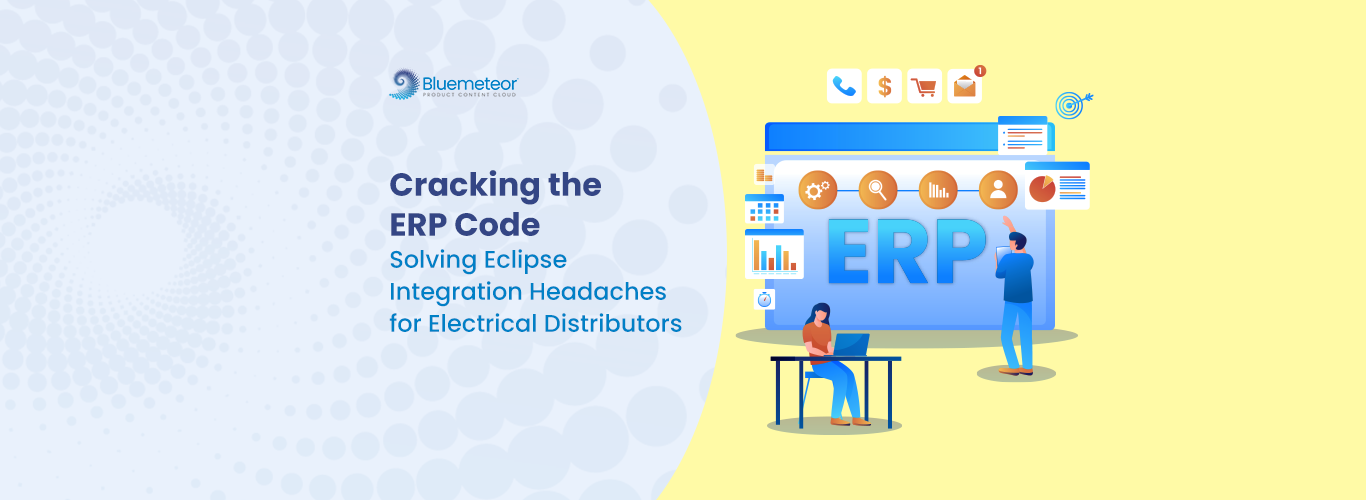
If you’re an electrical distributor, chances are you’ve encountered the robust system that is Epicor Eclipse ERP. It’s a powerful, deeply embedded system built for high-volume transactions and complex supply chains. But when it comes to Eclipse ERP integration, particularly with Product Information Management (PIM) systems or eCommerce platforms, things get… messy.
- Manual SKU entry
- Pricing table mismatches
- Format errors
- Endless support tickets
It’s not because Eclipse is outdated. It’s because it wasn’t designed for today’s product content demands – enriched attributes, digital assets, SEO fields, and omnichannel delivery. That’s where Bluemeteor comes in – not to replace Eclipse, but to extend it.
To understand the solution, let’s first break down why these issues happen – and then explore how Bluemeteor’s Product Content Cloud effectively fills the gap with clean, scalable integration.
Why Is Epicor Eclipse So Widely Used Yet So Hard to Integrate?
Epicor Eclipse remains the backbone ERP system for thousands of electrical distributors. Its transactional model is rock-solid when it comes to order fulfillment and inventory management.
However, that same precision comes with rigidity. Because it’s designed around a transactional core, not a modern, content-rich product experience, integrating it with newer systems can present challenges.
Therefore, it shows its age when asked to support:
- Manual Data Entry Overload: Every new SKU, price update, or supplier change means someone has to manually input data into Eclipse.
- Formatting Rejections and Data Errors: Eclipse expects data to arrive in a very specific structure. Any misalignment in product category, unit of measure, or attribute formatting leads to import errors.
- Delayed Catalog Updates: Distributors struggle to push seasonal or supplier-driven updates fast enough, delaying product availability online.
- Inflexible Data Models: Rich data from IDEA, DDS, AD, or Trade Service rarely fits Eclipse’s structure without heavy manipulation.
- Custom Legacy Builds: Many older Eclipse instances have undocumented customizations that make automation feel impossible.
- Lack of Support for Enriched Content: SEO metadata, eCommerce attributes, digital assets like images, PDFs, videos and other marketing data can’t live in Eclipse, so where does it go?
That’s because Eclipse ERP isn’t designed to manage rich product content. And its rigid structure makes it difficult to plug in external product data – especially from industry sources like IDEA, DDS, Trade Service, or AD.
Add in custom configurations and limited API capabilities, and most integration attempts fall into one of three traps, simply put:
- Manual entry overload
- Formatting rejections and data errors
- Inefficient batch processing or clunky middleware
Common Eclipse ERP Integration Challenges Electrical Distributors Face
The distributors we work with often report the same recurring frustrations. So, to understand the root of the issue, let’s take a closer look at the most common integration failures:
- Data Normalization Nightmares: You receive feeds from Trade Service, IDEA, DDS, AD – all formatted differently. Getting them to match Eclipse’s schema is a manual grind.
- Pricing Table Conflicts: Complex tiered pricing or contract pricing often doesn’t align with Eclipse’s standard tables.
- SKU Creation Bottlenecks: New products take days to get live because SKU creation is manual and error prone.
- Attribute Mismatches: Units of measure, product specs, and vendor part numbers often fail Eclipse’s import checks.
- eCommerce Integration Gaps: Your eCommerce platform needs enriched product content, but Eclipse can’t deliver it.
In short: when PIM and ERP integration fails, your entire digital ecosystem suffers.
Bluemeteor: Solving Eclipse ERP Integration Without the Headaches
This is where Bluemeteor’s Product Content Cloud steps in. Instead of forcing Eclipse to handle product data it was never built for, Bluemeteor creates a separation of duties:
- ERP like Eclipse handles operational data (inventory, pricing, order management).
- PIM like Bluemeteor manages marketing content, enrichment, supplier feeds, and more…
Our goal isn’t to replace Eclipse – it’s to work with it, making it more capable by feeding it the right data, in the right format, at the right time.
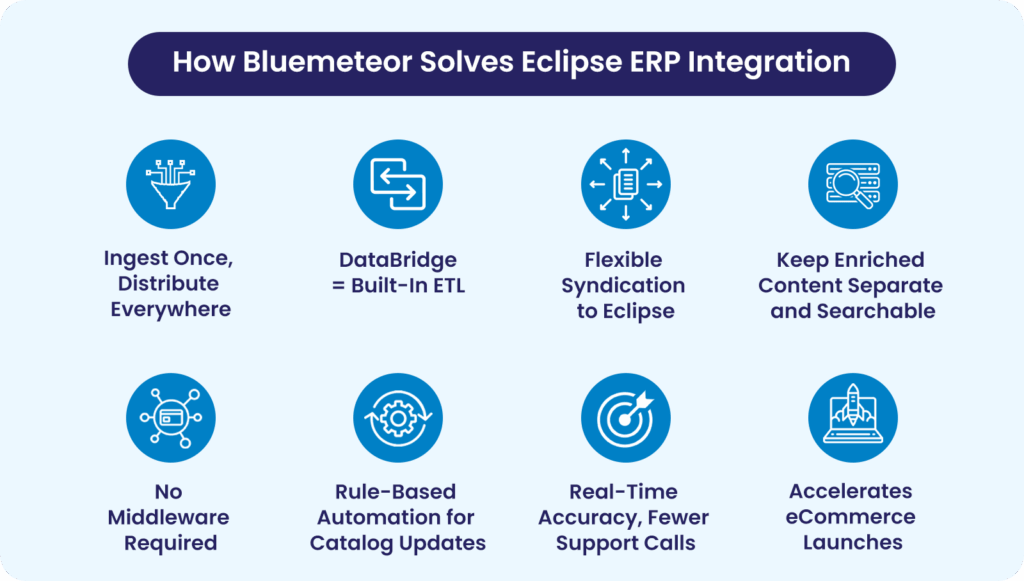
How It Works:
1. Ingest Once, Distribute Everywhere
Bluemeteor ingests supplier data from DDS, IDEA, AD, and Trade Service – as well as direct manufacturing feeds. It normalizes and enriches the data, so you don’t have to.
2. DataBridge = Built-In ETL
Our DataBridge technology, therefore, acts as a powerful ETL engine, transforming messy input data into clean, Eclipse-ready formats. It efficiently handles field mapping, attribute alignment, validation, and custom business rules, ensuring that every piece of data is ready to seamlessly integrate into your ERP system.
3. Flexible Syndication to Eclipse
Whether Eclipse requires flat files, CSV, or API-based input – its deliver’s validated product records in the exact structure it needs. That includes pricing, categories, and product specs.
4. Keep Enriched Content Separate and Searchable
Eclipse handles operations. Meanwhile, Bluemeteor handles experience. Our platform seamlessly manages SEO metadata, digital assets, long descriptions, and marketing content separately – all optimized for eCommerce.
5. No Middleware Required
Instead of adding another integration layer, Bluemeteor becomes your central source of truth. One platform to rule your product data, syndicating clean records into Eclipse without custom scripts.
6. Rule-Based Automation for Catalog Updates
With Bluemeteor, you can leverage automation rules to seamlessly push seasonal updates, supplier refreshes, or pricing changes, all with less human involvement and fewer errors. As a result, your catalog management becomes more efficient and accurate.
7. Real-Time Accuracy, Fewer Support Calls
By ensuring validated data, Bluemeteor minimizes ERP errors, leading to fewer IT tickets and reduced internal support needs. Consequently, your team can focus on growth rather than spending time fixing broken feeds and correcting discrepancies.
8. Accelerates eCommerce Launches
Furthermore, by decoupling marketing and product data needs from Eclipse’s constraints, Bluemeteor enables faster eCommerce growth. This ensures that you have clean, enriched data at every touchpoint, helping you launch quickly and scale efficiently.
The result?
- No formatting issues.
- No manual entry.
- No surprise errors.
Distributors using Bluemeteor with Eclipse have unlocked:
- Automated SKU onboarding that replaces error-prone manual processes
- Quarterly catalog updates in hours, not weeks
- Accurate pricing and product attribute mapping across systems
- Support ticket volume reductions due to clean, validated data flows
- Scalable eCommerce growth thanks to enhanced product content management
And because Bluemeteor supports consistent ERP and PIM experiences, teams across operations, eCommerce, and sales finally speak the same data language.
That means:
- No more guesswork, and no more backlogs.
- Clean operational product data in Eclipse
- Rich, optimized content for your eCommerce channels
- Unified workflows without duplication or rework
- One source of truth across teams
Just a seamless product content flow from idea to Eclipse to eCommerce.
Why It Matters for eCommerce and Electrical Distributors
You can’t scale digital sales on broken foundations. When Eclipse ERP and your PIM are out of sync, your storefront suffers:
- Wrong prices
- Missing product specs
- Incomplete descriptions
- Delayed launches
Bluemeteor effectively solves this by acting as the critical data normalization layer between your product sources and Eclipse. In other words, everything you need flows seamlessly to the right place, in the right format, and at the right time.
Thus, modern distributors are able to scale their online catalogs without the need to scale their support teams.
Ready to Eliminate Your Eclipse Integration Headaches?
If you’re still wrestling with Eclipse ERP integration, the problem isn’t your data. It’s the system trying to manage what it wasn’t built for.
Bluemeteor’s Product Content Cloud was built specifically for this purpose. In fact, we’ve successfully solved Eclipse integration challenges for some of the industry’s most complex environments. Now, let’s do the same for you.
Book a call with our team or let us walk you through a personalized FREE demo!
Let’s future-proof your operations–starting today.

